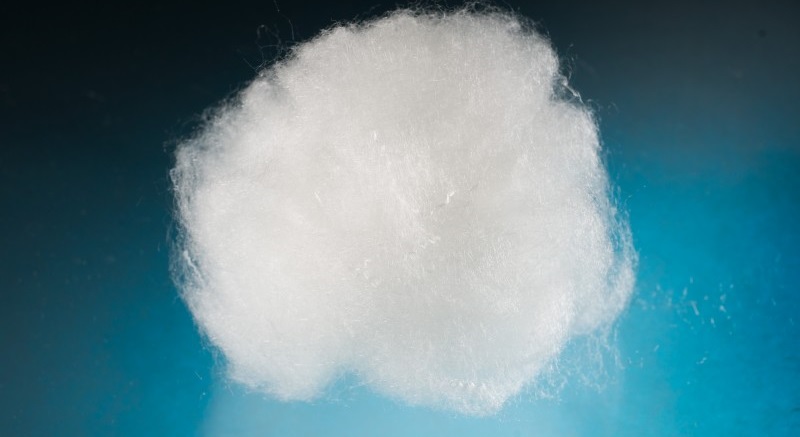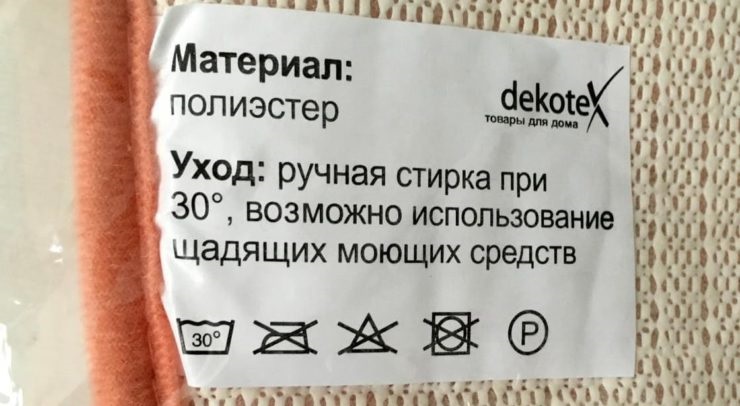Does polyester shrink after washing?
 The popularity of things made of polyester is easy to explain: the material is inexpensive, aesthetic, wear-resistant and practical. It is also attractive that this synthetic material is easy to care for - the clothes can be washed in a machine and ironed. But before you throw the fabric into a basin or drum, it’s worth figuring out whether the polyester shrinks after washing. We suggest that you do not rely on “maybe”, but consider in detail the reaction of synthetics to water and iron.
The popularity of things made of polyester is easy to explain: the material is inexpensive, aesthetic, wear-resistant and practical. It is also attractive that this synthetic material is easy to care for - the clothes can be washed in a machine and ironed. But before you throw the fabric into a basin or drum, it’s worth figuring out whether the polyester shrinks after washing. We suggest that you do not rely on “maybe”, but consider in detail the reaction of synthetics to water and iron.
Is polyester prone to warping?
Polyester is made from polyester fibers. This is a synthetic material that has many undeniable advantages. Among the advantages, the following characteristics stand out:
- wear resistance and strength of fabric;
- ease of wearing;
- low manufacturing cost;
- presence of water-repellent properties;
- the ability of the material to resist fading and unpleasant odors.
The main “advantage” of polyester is practicality. The material holds its shape perfectly and retains its structure even after frequent washing and prolonged wear. By the way, it is polyester fibers that are used to stuff pillows and down jackets, which allows the products to be used for a long time without cleaning.
Due to the strength of the material and resistance to deformation, “pure” polyester practically does not change in size after the first wash. Minimal shrinkage is possible, which is so slight that it remains completely unnoticeable. True, this only works if the cleaning is properly organized.
Polyester also has disadvantages. Most of them include standard synthetic “problems”:
- the material does not “breathe”, does not allow air to pass through well, and floats;
- highly electrified.
If, in addition to polyester, the fabric contains natural materials, then severe shrinkage is possible!
To correct the situation with electrification and poor breathability, manufacturers stopped using “pure” polyester, diluting it with natural materials - cotton, linen, wool, viscose. The result is mixed fabrics that are breathable and pleasant to wear. But now semi-natural things can shrink if not properly cared for.
How are we going to wash it?
Polyester shrinkage can be avoided if you follow certain rules. First of all, we look at the label, where the manufacturer indicates the nuances of caring for the item. As a rule, products consisting of 100% polyester fibers can be easily washed by both hand and machine. Mixed fabrics are cleaned depending on the proportion of natural materials, but it is better not to risk it and wash such clothes by hand.
Before washing the item, read the factory label with the manufacturer's recommendations!
When washing polyester items in an automatic machine, you need to remember important nuances.
- Liquid detergents are recommended. If you are washing 100% polyester or items with polyester filling, then it is better to opt for gels. The powder dissolves less well and settles in the fibers, disrupting the structure of the material.
- Air conditioning wouldn't hurt. The rinse aid will help “knock down” static electricity from the fibers, making the item softer and more delicate.
- Preparation is important. Before loading into the drum, items must be sorted by color, turned inside out and placed in a special bag.

- Stains are removed by hand. It is better to treat local contamination with soap and a brush before starting the cycle and soak for half an hour.If a large area is dirty or the dirt has dried, the “Pre-wash” mode will help out.
- Choosing the right program. You need a gentle mode, for example, “Delicate”, “Manual” or “Sport”. If the item only needs to be refreshed, then “Quick Wash” is also suitable.
- Duplicate the rinse. It is important to completely remove the detergent from the fabric, so we turn on an additional rinse cycle.
- Wash in cold water. The ideal temperature for polyester is 30-40 degrees; if it’s hotter, the material will deteriorate.
- We refuse spinning. Maximum - 600-800 rpm; when washing thin blouses and shirts, it is better to turn it off or reduce it to 400.
If the manufacturer insists on hand washing, then it is better not to risk it. In a basin, things are washed subject to similar requirements. First of all, this concerns the water heating temperature - the same 30-40 degrees. Remember that even at 50 degrees polyester begins to deteriorate.
The detergent is selected to be soft and gentle. Ideally, a synthetic gel with color preservation function is used.. There is no need to rub the fabric vigorously; just soak the item in a soapy solution and then press it until the dirt is removed. Rinse clothes until the water becomes clear. Polyester fibers cannot be bleached or wrung out - this can damage the structure. It is better to take out the wet laundry, put it on the bottom of the bath and let the moisture drain on its own.
How to get rid of moisture and how to iron it?
To dry a semi-wet polyester item, do not resort to artificial drying, direct sunlight or radiators. It is enough to hang clothes on a drying rack or line in a ventilated room or on the balcony. It is better to avoid creases and hang washed items on hangers.
When drying polyester, it is necessary to avoid direct sunlight and heating devices!
There is no need to iron things made of 100% synthetics - the material perfectly restores its shape. As a last resort, you can use an iron, but only at an average temperature of 110 degrees and through a damp cotton cloth. It is better to start ironing from an inconspicuous area, a lapel or a cuff - if the fabric melts, then you need to moisten it generously.
When ironing items made from mixed fabrics, it is important to follow the manufacturer's recommendations. The temperature and duration of the procedure depend on the amount and type of natural fibers, and for some items, manipulation with artificial heat is completely prohibited. But, as a rule, on most polyester clothes there is an icon in the form of an iron with one dot. This means that you can iron, but at minimum degrees.
Polyester and mixed fabrics based on it are comfortable to wear and care for. The main thing is not to forget about the manufacturer’s recommendations and act with extreme caution.
Interesting:
Reader comments
- Share your opinion - leave a comment





















Add a comment